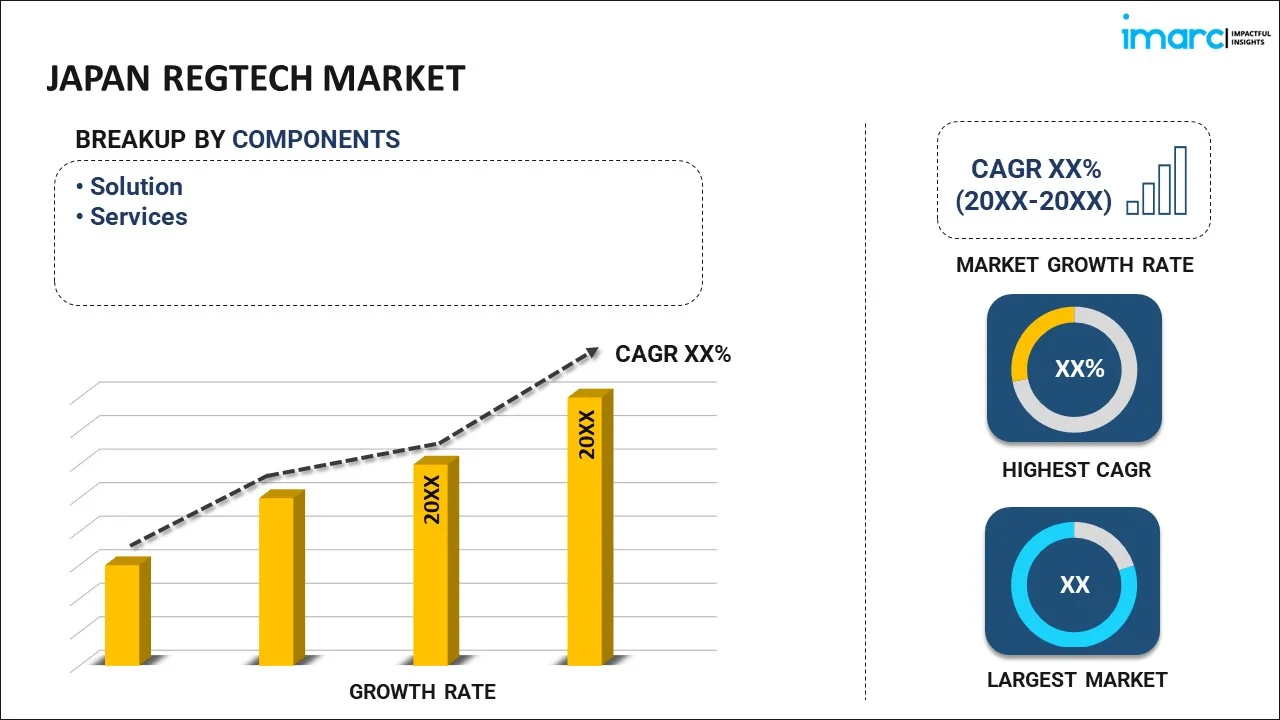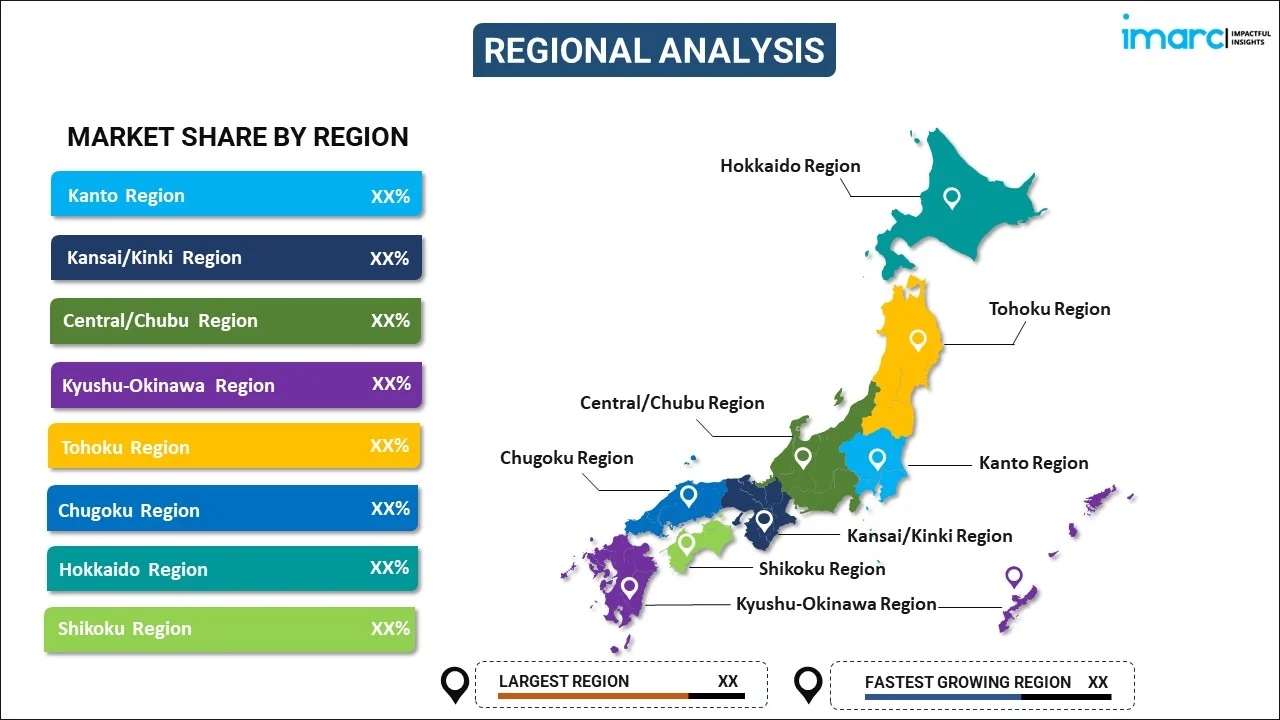
Japan RegTech Market Report by Component (Solution, Services), Deployment Mode (Cloud-based, On-premises), Enterprise Size (Large Enterprises, Small and Medium-sized Enterprises), Application (Anti-Money Laundering (AML) and Fraud Management, Regulatory Intelligence, Risk and Compliance Management, Regulatory Reporting, Identity Management), End User (Banks, Insurance Companies, FinTech Firms, IT and Telecom, Public Sector, Energy and Utilities, and Others), and Region 2025-2033
Market Overview:
Japan RegTech market size reached USD 726.8 Million in 2024. Looking forward, IMARC Group expects the market to reach USD 2,917.8 Million by 2033, exhibiting a growth rate (CAGR) of 15.20% during 2025-2033. The increasing demand for technologies, such as artificial intelligence (AI) and machine learning (ML) to analyze and extract actionable insights from this data, making compliance more efficient, is primarily driving the market.
|
Report Attribute
|
Key Statistics
|
|---|---|
|
Base Year
|
2024 |
|
Forecast Years
|
2025-2033
|
|
Historical Years
|
2019-2024
|
| Market Size in 2024 | USD 726.8 Million |
| Market Forecast in 2033 | USD 2,917.8 Million |
| Market Growth Rate (2025-2033) | 15.20% |
RegTech, short for regulatory technology, is a rapidly evolving field within the financial industry that leverages technology to help organizations efficiently and effectively comply with complex regulatory requirements. RegTech solutions encompass a wide range of tools and software applications, such as data analytics, artificial intelligence, machine learning, and blockchain, to automate and streamline compliance processes. By harnessing the power of these technologies, RegTech enables financial institutions and other regulated entities to stay ahead of ever-changing regulatory landscapes. It helps them manage risk, reduce compliance costs, and enhance transparency. RegTech solutions can automate tasks like data collection, reporting, and monitoring, allowing organizations to allocate resources more efficiently and make data-driven decisions. In a world where regulatory demands continue to grow in complexity, RegTech plays a vital role in ensuring that businesses can navigate this landscape while maintaining their competitive edge. It promotes innovation in compliance, ultimately benefiting both organizations and regulators by improving regulatory compliance outcomes.
Japan RegTech Market Trends:
The RegTech market in Japan, driven by a confluence of factors, has been experiencing remarkable growth in recent years. Firstly, the escalating regulatory complexity across industries has necessitated the adoption of advanced technology solutions to streamline compliance processes. Consequently, financial institutions and businesses are increasingly turning to RegTech solutions to navigate the labyrinthine landscape of regulatory requirements. Additionally, the surge in data volumes has played a pivotal role in propelling the RegTech sector forward. The proliferation of digital transactions and the exponential growth of data have created a pressing need for automated tools that can efficiently process and analyze vast amounts of information. This has prompted organizations to invest in RegTech solutions that can provide real-time data insights and enhance decision-making processes. Furthermore, the evolving threat landscape, which has underscored the importance of cybersecurity in regulatory compliance, is expected to drive the RegTech market in Japan.
Japan RegTech Market Segmentation:
IMARC Group provides an analysis of the key trends in each segment of the market, along with forecasts at the country level for 2025-2033. Our report has categorized the market based on component, deployment mode, enterprise size, application, and end user.
Component Insights:

- Solution
- Services
The report has provided a detailed breakup and analysis of the market based on the component. This includes solution and services.
Deployment Mode Insights:
- Cloud-based
- On-premises
A detailed breakup and analysis of the market based on the deployment mode of manufacturer have also been provided in the report. This includes cloud-based and on-premises.
Enterprise Size Insights:
- Large Enterprises
- Small and Medium-sized Enterprises
The report has provided a detailed breakup and analysis of the market based on the enterprise size. This includes large enterprises and small and medium-sized enterprises.
Application Insights:
- Anti-Money Laundering (AML) and Fraud Management
- Regulatory Intelligence
- Risk and Compliance Management
- Regulatory Reporting
- Identity Management
A detailed breakup and analysis of the market based on the application have also been provided in the report. This includes anti-money laundering (AML) and fraud management, regulatory intelligence, risk and compliance management, regulatory reporting, and identity management.
End User Insights:
- Banks
- Insurance Companies
- FinTech Firms
- IT and Telecom
- Public Sector
- Energy and Utilities
- Others
The report has provided a detailed breakup and analysis of the market based on the end user. This includes banks, insurance companies, fintech firms, IT and telecom, public sector, energy and utilities, and others.
Regional Insights:

- Kanto Region
- Kansai/Kinki Region
- Central/ Chubu Region
- Kyushu-Okinawa Region
- Tohoku Region
- Chugoku Region
- Hokkaido Region
- Shikoku Region
The report has also provided a comprehensive analysis of all the major regional markets, which include Kanto Region, Kansai/Kinki Region, Central/ Chubu Region, Kyushu-Okinawa Region, Tohoku Region, Chugoku Region, Hokkaido Region, and Shikoku Region.
Competitive Landscape:
The market research report has also provided a comprehensive analysis of the competitive landscape in the market. Competitive analysis such as market structure, key player positioning, top winning strategies, competitive dashboard, and company evaluation quadrant has been covered in the report. Also, detailed profiles of all major companies have been provided.
Japan RegTech Market Report Coverage:
| Report Features | Details |
|---|---|
| Base Year of the Analysis | 2024 |
| Historical Period | 2019-2024 |
| Forecast Period | 2025-2033 |
| Units | Million USD |
| Scope of the Report | Exploration of Historical and Forecast Trends, Industry Catalysts and Challenges, Segment-Wise Historical and Predictive Market Assessment:
|
| Components Covered | Solution, Services |
| Deployment Modes Covered | Cloud-based, On-premises |
| Enterprise Sizes Covered | Large Enterprises, Small and Medium-sized Enterprises |
| Applications Covered | Anti-Money Laundering (AML) and Fraud Management, Regulatory Intelligence, Risk and Compliance Management, Regulatory Reporting, Identity Management |
| End Users Covered | Banks, Insurance Companies, FinTech Firms, IT and Telecom, Public Sector, Energy and Utilities, Others |
| Regions Covered | Kanto Region, Kansai/Kinki Region, Central/ Chubu Region, Kyushu-Okinawa Region, Tohoku Region, Chugoku Region, Hokkaido Region, Shikoku Region |
| Customization Scope | 10% Free Customization |
| Post-Sale Analyst Support | 10-12 Weeks |
| Delivery Format | PDF and Excel through Email (We can also provide the editable version of the report in PPT/Word format on special request) |
Key Questions Answered in This Report:
- How has the Japan RegTech market performed so far and how will it perform in the coming years?
- What has been the impact of COVID-19 on the Japan RegTech market?
- What is the breakup of the Japan RegTech market on the basis of component?
- What is the breakup of the Japan RegTech market on the basis of deployment mode?
- What is the breakup of the Japan RegTech market on the basis of enterprise size?
- What is the breakup of the Japan RegTech market on the basis of application?
- What is the breakup of the Japan RegTech market on the basis of end user?
- What are the various stages in the value chain of the Japan RegTech market?
- What are the key driving factors and challenges in the Japan RegTech?
- What is the structure of the Japan RegTech market and who are the key players?
- What is the degree of competition in the Japan RegTech market?
Key Benefits for Stakeholders:
- IMARC’s industry report offers a comprehensive quantitative analysis of various market segments, historical and current market trends, market forecasts, and dynamics of the Japan RegTech market from 2019-2033.
- The research report provides the latest information on the market drivers, challenges, and opportunities in the Japan RegTech market.
- Porter's five forces analysis assist stakeholders in assessing the impact of new entrants, competitive rivalry, supplier power, buyer power, and the threat of substitution. It helps stakeholders to analyze the level of competition within the Japan RegTech industry and its attractiveness.
- Competitive landscape allows stakeholders to understand their competitive environment and provides an insight into the current positions of key players in the market.
Need more help?
- Speak to our experienced analysts for insights on the current market scenarios.
- Include additional segments and countries to customize the report as per your requirement.
- Gain an unparalleled competitive advantage in your domain by understanding how to utilize the report and positively impacting your operations and revenue.
- For further assistance, please connect with our analysts.
 Inquire Before Buying
Inquire Before Buying
 Speak to an Analyst
Speak to an Analyst
 Request Brochure
Request Brochure
 Request Customization
Request Customization




.webp)




.webp)












